Friday, February 24, 2012
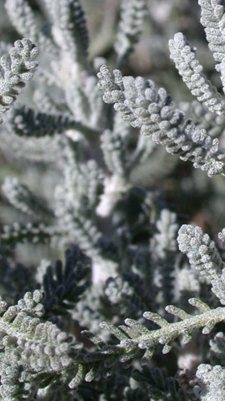
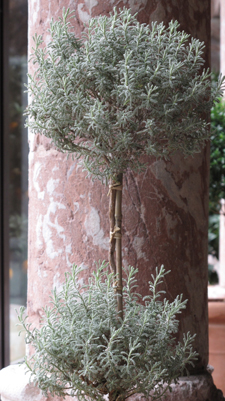
The ‘evergray’ santolina is cold hardy in our climate, but dislikes our wet winters. We prefer to grow this aromatic herb in pots and bring it indoors in autumn. Above, left: Santolina is also known as cotton lavender, because of its dense, whitish-gray foliage and strong fragrance; Right: A santolina topiary made from a dwarf form of the species.
A compact, woody plant of dry ground and stony banks, the Mediterranean santolina (Santolina chamaecyparissus) is cold hardy in our USDA Zone 7 gardens, but dislikes wintering over in wet soil; we prefer to grow it in pots and bring it indoors in autumn. Santolina’s slender stems are densely covered with short, thick, cottony leaves. This low-growing evergray species lends itself to shaping and shearing, and was widely used as an ornamental edging plant in Renaissance knot gardens. It’s also an excellent subject for topiary work, especially the dwarf form of the species, S. chamaecyparissus ‘Nana.’
Read more »
Tags: Andres de Laguna, artemisia, cherry, cornelian, Cornus europaea, cornus mas, De Materia Medica, Dioscorides, evergray, santolina, Santolina chamaecyparissus, southernwood, topiary, wormwood
Posted by Deirdre Larkin on Friday, February 24 at 2:27 pm | Comments (2)
Friday, February 10, 2012
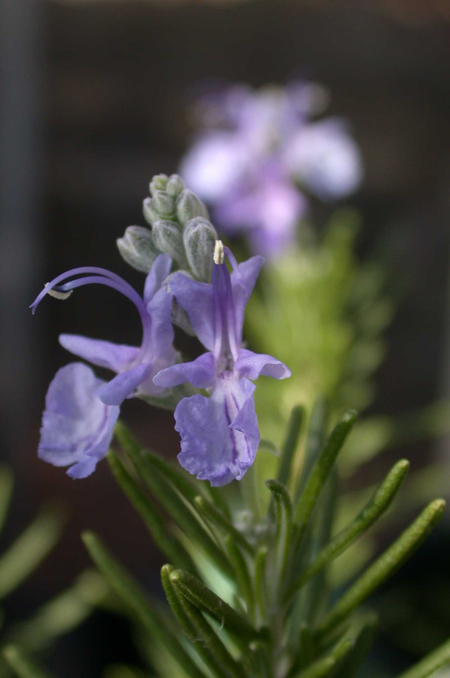
In the later Middle Ages, the leaves, stems, and flowers of this aromatic??member of the mint family??were used to effect cures for many ills, and provide protection from both spiritual and bodily harm. Photograph by Nathan Heavers
Libanotis which the Romans call Rosmarinus & they which plait crowns use it: the shoots are slender, about which are leaves, small, thick, and somewhat long, thin, on the inside white, but on the outside green, of a strong scent. It hath a warming facultie . . .
???Dioscorides, De Materia Medica, Book III: 89
It is an holy tree and with folk that hath been rightful and just gladly it groweth and thriveth. In growing it passeth not commonly in height the height of our Lord Jesu Christ while he walked as a man on earth, that is man’s height and half, as man is now; nor, after it is 33 years old, it growth not in height but waxeth in breadth and that but little. It never seareth all but if some of the aforesaid four weathers make it.
???Friar Henry Daniel, “little book of the virtues of rosemary,” ca. 1440
Read more »
Tags: Dioscorides, Hortulus, rosemary, Rosmarinus officinalis, Salerno, St. Gall, Walahfrid Strabo, Westminster, Wilton Diptych
Posted by Deirdre Larkin on Friday, February 10 at 3:45 pm | Comments (1)
Friday, February 3, 2012
The trees went to anoint a king over them: and they said to the olive tree: Reign thou over us
And it answered: Can I leave my fatness, which both gods and men make use of, to come to be promoted among the trees?
???Judges 9: 8-9, Douay-Rheims Bible
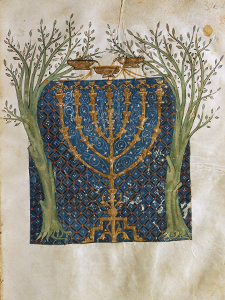

Olive oil provided fuel for sanctuary lamps throughout the Mediterranean world in antiquity and the Middle Ages, as well as holy oils for religious purposes. Above, left: A menorah flanked by two olive trees, as depicted in the Cervera Bible, recently on view at the Main Building. The brimming vessels?? used to fill the lamp appear at the top of the menorah. Right: A fifth-century standing lamp decorated with a cross; bronze lamps of this type were common in the early Byzantine world.
The olive was held to be the first of trees in both classical and biblical antiquity, prized above even the grapevine and the fig. A gift of the goddess Athena, the sacred olive symbolized the arts of peace and prosperity; the ruthless destruction of an enemy’s olive groves in wartime was held to be sacrilegious act. The Roman natural historian Pliny, writing in the first century A.D., attests that Athena’s olive was still venerated on the Athenian acropolis in his day (Historia naturalis, XVI 239???40). Although slow to bear, the tree is very long lived, surviving for hundreds of years. (The SpiceLines blog features an illustrated post about a Spanish olive estimated to be eighteen hundred years old.)
Read more »
Tags: chrism, drupe, glucoside, Hildegard of Bingen, Mediterranean, oil, oleaster, olive, Physica, Pliny, Tacuinum Sanitatis
Posted by Deirdre Larkin on Friday, February 3 at 2:29 pm | Comments (0)
Friday, January 27, 2012
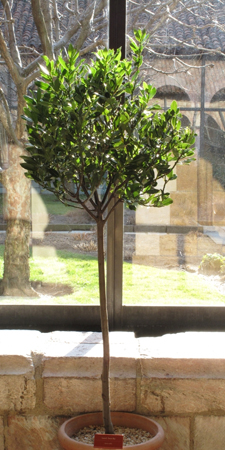
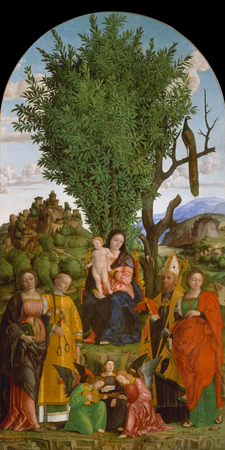
The evergreen bay laurel (Laurus nobilis), a symbol of victory and eternal life, is not as tender as some other Mediterranean species, but it must be grown in pots and wintered over indoors at The Cloisters. Above, left: Bay laurel topiaries like this one spend the winter in the glassed-in arcades of Cuxa cloister and return to Bonnefont herb garden in May. Right: The magnificent bay tree that flourishes at the center of Girolamo dai Libri’s Madonna and Child with Saints represents Resurrection, and is juxtaposed with the naked limbs of a dead tree.
The laurel itself is a bringer of peace, inasmuch as to hold a branch of it out even between enemy armies is a token of cessation of hostilities. With the Romans especially it is used as a harbinger of rejoicing and of victory, accompanying despatches and decorating the spears and javelins of the soldiery and adorning the generals??? rods of office. From this tree a branch is deposited in the lap of Jupiter the All-good and All-great whenever a fresh victory has brought rejoicing, and this is not because the laurel is continually green, nor yet because it is an emblem of peace, as the olive is to be preferred in both respects, but because it flourishes in the greatest beauty on Mount Parnassus, and consequently is thought to be also dear to Apollo, to whose shrine even the kings of Rome at that early date were in the custom of sending gifts and asking for oracles in return.
???Pliny, Historia Naturalis, Book XV, 133
Read more »
Tags: Apollo, bay, cinnamon, Daphne, Dioscorides, evergreen, Girolamo dai Libri, Hildegard of Bingen, Jashemski, laurel, Laurus nobilis, Ovid, Pliny, Pompeii
Posted by Deirdre Larkin on Friday, January 27 at 4:50 pm | Comments (1)
Thursday, January 12, 2012
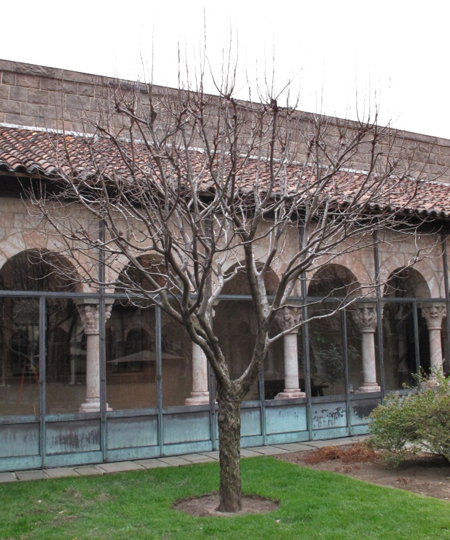
The pruning of our fruit trees is undertaken in winter, when the trees are dormant. Above: One of four pollarded crab apples in need of pruning in Cuxa garden
The first important horticultural task of the New Year was the pruning of the crab apples in Cuxa cloister garth garden. (This year, the work was performed on Plough Monday, the traditional day on which farmers and workers returned to the fields after the Christmas rest. For a nineteenth-century account of the history of Plough Monday in English tradition, see Chambers’s Journal of popular literature, science and arts, Vol. 56.) Read more »
Tags: crab apple, pollard
Posted by Deirdre Larkin on Thursday, January 12 at 1:14 pm | Comments (5)
Thursday, December 15, 2011
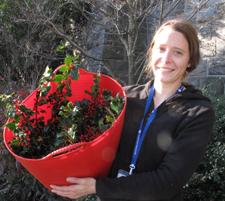
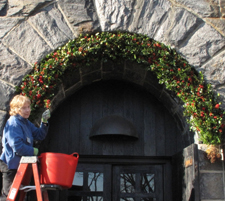
Above, from left to right: Gardener Esme Webb carrying a trug of English holly; volunteer Nuala Outes putting berried holly branches into the arch over the postern gate entrance.
Visitors entering the Museum by the postern gate (the main entrance to The Cloisters) from now through the first week of January will pass under a great arch of holly, the plant most strongly associated with the medieval celebration of Christmastide. (For more on the medieval significance of this beautiful and beloved tree, see “The Holly and The Ivy,” December 18, 2008). The ceremonial placing of a beneficent plant above a doorway is an ancient practice common to many cultures and periods. (Four of the doorways in the Main Hall are adorned with arches of ivy, apples, hazelnuts, and rose hips; see “Decking the Halls: The Arches,” December 2, 2008.) Read more »
Tags: apple, Christmastide, dioecious, hazelnut, holly, ivy, rose hip
Posted by Deirdre Larkin on Thursday, December 15 at 3:47 pm | Comments (4)
Thursday, December 8, 2011
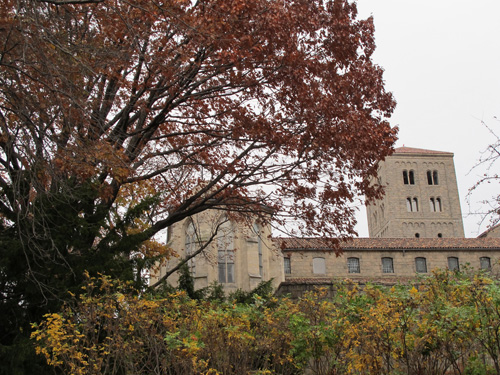
An Eastern black oak (Quercus velutina) outside The Cloisters.?? Photograph by Theo Margelony
Its wood is strong and hard and durable. Its beams supported high roofs over castles and churches. Its boards closed off doorways and gateways, denying passage to all but the most obstinate or determined, and were used to create interior floors from small chambers to large halls. Panels of it were shaped and carved into chests and choir stalls. Its planks were worked into ships and bridges, wagons and carts. Read more »
Tags: acorn, fructed, heraldry, oak, Quercus
Posted by R. Theo Margelony on Thursday, December 8 at 12:22 pm | Comments (7)
Friday, November 25, 2011
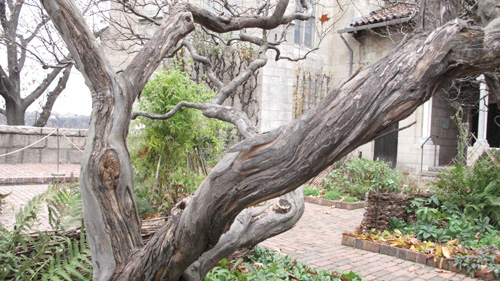
Now that this??veteran quince has regained vigor and the branches have grown thicker, the bark is splitting under the pressure of the increased diameter. The plates formed by the??exfoliating bark add to the beauty and ornamental value of the tree.
The beloved and beautiful quartet of quince (Cydonia oblonga) trees at the center of Bonnefont garden, an iconic image of The Cloisters worldwide, was showing??its age when I first came to The Cloisters as consulting arborist in 2007. The trees were nutritionally deprived, had suffered from both summer and winter drought, and were subject to several fungal diseases, as well as insect infestations, especially apple maggot. Read more »
Tags: apple maggot, bark, Cydonia oblonga, drought, fungal, insect, plating, quince
Posted by Fran Reidy on Friday, November 25 at 9:15 am | Comments (11)
Friday, November 18, 2011
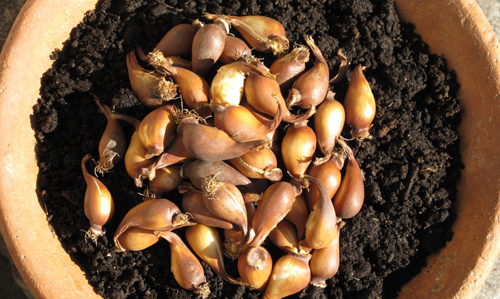
These small bulbs of Tulipa biflora, a species native to the Southern Balkans and Southeastern Russia, are to be planted today in Cuxa garden, the only one of our three gardens in which ??post-medieval plants are grown. The tulip did not reach Europe until the sixteenth century.?? Photograph by D. Larkin
Tulips, spring-blooming crocuses, winter aconites, fritillarias, and other bulbous plants native to Asia came too late to Europe to find a home in the medieval plant collections in Bonnefont and Trie gardens, but they do have an honored place in Cuxa cloister garden. Cuxa has been the main ornamental garden for the Museum since 1938, and has always included both modern and medieval plants in order to provide a continuous display from early spring until late fall. Read more »
Tags: Bulbs, Fritillaria, Holland, Linnaeus, tulip, Tulipa biflora, Tulipa humilis, Tulipa saxatilis, Tulipa turkestanica, winter aconite
Posted by Deirdre Larkin on Friday, November 18 at 2:21 pm | Comments (0)
Friday, October 28, 2011
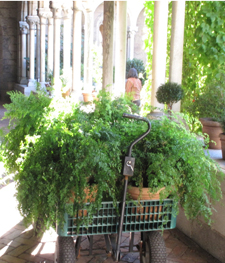
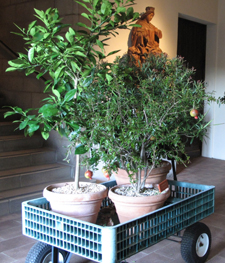
Potted plants too tender to spend the winter in Bonnefont garden are trucked inside and brought up to Cuxa cloister, which is??glazed in mid-October. Mediterranean plants such as bitter orange, myrtle, and bay laurel spend the cold season in the sunny arcades and??are brought back out to the herb garden when the glass comes down in mid-April. Left:??A wagonload of maidenhair fern in the arcade of Bonnefont garden. Right:??oranges and pomegranates en route to Cuxa cloister.?? Photographs by Carly Still
While the medieval plant collection at The Cloisters includes a good number of northern European species, a great many of the plants grown in the Bonnefont Cloister herb garden are Mediterranean in origin. Not all of these southern European plants are hardy for us here in New York City. The garden is a sheltered U.S.D.A. Hardiness Zone 7, and the fig tree (Ficus carica), poet’s jasmine (Jasminum officinale), and lavender (Lavandula angustifolia) do just fine outdoors, but more tender species like bitter orange (Citrus aurantium), rosemary (Rosmarinus officinalis), bay laurel (Laurus nobilis), and dittany of Crete (Origanum dictamnus) must be brought inside and protected from the cold. Read more »
Tags: Albertus Magnus, bay, Citrus aurantium, cucumber, cucurbit, dittany, fern, ficus carica, fig, jasmine, Jasminum officinale, laurel, Laurus nobilis, Lavandula angustifolia, Lavender, maidenhair, myrtle, orange, Origanum dictamnus, rosemary, Rosmarinus officinalis, santolina, winter
Posted by Deirdre Larkin on Friday, October 28 at 1:59 pm | Comments (2)















